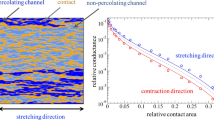Abstract
We consider a dense network of elastic materials modeled by a dense network of elastic disks. More specifically, we consider a dense network of elastic disks in the unit disk \(D(0,1)\) of \(\mathbb{R}^{2}\) obtained from an Apollonian packing of elastic circular disks by removing disks of small sizes. We suppose that the disks are pressed against each other to form small rectilinear contact zones where a perfect adhesion occurs on thinner zones. We use \(\Gamma\)-convergence methods in order to study the asymptotic behavior of the structure with respect to a vanishing parameter describing the thickness of the small perfect contact lines between materials. We derive an effective boundary condition on the residual fractal interface obtained by removing the Apollonian network of disks from \(D(0,1)\).
Similar content being viewed by others
References
S. V. Anishchik and N. N. Medvedev, “Three-dimensional Apollonian packing as a model for dense granular systems”, Phys. Rev. Lett., 75 (1995), 4314–4317.
H. Attouch, Variational convergence for functions and operators, Appl. Math. Series, Pitman, Boston–London–Melbourne, 1984.
Y. Ben-Zion and C. G. Sammis, “Characterization of fault zones”, Pure and Applied Geophysics, 160 (2003), 677–715.
D. W. Boyd, “The residual set dimension of Apollonian packing”, Mathematika, 20 (1973), 170–174.
R. Capitanelli, M. R. Lancia, and M. A. Vivaldi, “Insulating layers of fractal type”, Differential Integral Equations, 26:9/10 (2013), 1055–1076.
G. Dal Maso, An Introduction to \(\Gamma \)-convergence, Progress in Nonlinear Differential Equations and Applications, vol. 8, Birkhäuser, Basel, 1993.
M. El Jarroudi, “Asymptotic analysis of contact problems between an elastic material and thin-rigid plates”, Appl. Anal., 89:5 (2010), 693–715.
M. El Jarroudi and M. Er-Riani, “Homogenization of elastic materials containing self-similar microcracks”, Quart. J. Mech. Appl. Math, 72:2 (2019), 131–155.
M. El Jarroudi and A. Brillard, “Asymptotic behaviour of contact problems between two elastic materials through a fractal interface”, J. Math. Pures Appl., 89:5 (2008), 505–521.
K. Falconer, Techniques in Fractal Geometry, J. Wiley & Sons, Chichester, 1997.
H. J. Herrmann, G. Mantica, and D. Bessis, “Space-filling bearings”, Phys. Rev. Lett., 65:26 (1990), 3223–3226.
H. Hertz, “Über die berührung fester elastischer körper”, J. Rein. Angew. Math., 92 (1882), 156–171.
P. W. Jones, “Quasiconformal mappings and extendability of functions in Sobolev spaces”, Acta Math., 147:1–2 (1981), 71–88.
A. Jonsson and H. Wallin, “Boundary value problems and Brownian motion on fractals”, Chaos Solitons Fractals, 8:2 (1997), 191–205.
J. C. Kim, K. H. Auh, and D. M. Martin, “Multi-level particle packing model of ceramic agglomerates”, Model. Simul. Mater. Sci. Eng., 8 (2000), 159–168.
M. R. Lancia, “A transmission problem with a fractal interface”, Z. Anal. Anwend., 21:1 (2002), 113–133.
C. Marone, C. B. Raleigh, and C. H. Scholz, “Frictional behavior and constitutive modeling of simulated fault gouge”, J. Geoph. Res., 95:B5 (1990), 7007–7025.
R. D. Mauldin and M. Urbański, “Dimension and measures for a curvilinear Sierpinski gasket or Apollonian packing”, Adv. Math., 136:1 (1998), 26–38.
U. Mosco and M. A. Vivaldi, “Fractal reinforcement of elastic membranes”, Arch. Ration. Mech. Anal., 194 (2009), 49–74.
U. Mosco and M. A. Vivaldi, “Thin fractal fibers”, Math. Meth. Appl. Sci., 36:15 (2013), 2048–2068.
N. I. Muskhelishvili, Some basic problems of the mathematical theory of elasticity, Noordhoff, Groningen, 1963.
S. Roux, A. Hansen, and H. J. Herrmann, “A model for gouge deformation: Implication for remanent magnetization”, Geoph. Res. Lett., 20:14 (1993), 1499–1502.
V. S. Rychkov, “Linear extension operators for restrictions of function spaces to irregular open sets”, Studia Math., 140:2 (2000), 141–162.
C. G. Sammis and R. L. Biegel, “Fractals, fault-gouge, and friction”, Pure and Applied Geophysics, 131:1/2 (1989).
C. H. Scholz, The Mechanics of Earthquakes and Faulting, Cambridge University Press, Cambridge, 2002.
S. J. Steacy and C. G. Sammis, “An automaton for fractal patterns of fragmentation”, Nature, 353 (1991), 250–252.
D. Sullivan, “Entropy, Hausdorff measures old and new, and limit sets of geometrically finite Kleinian groups”, Acta. Math., 153:3–4 (1984), 259–277.
D. M. Walker and A. Tordesillas, Topological evolution in dense granular materials: A complex networks perspective, 47:5 (2010), 624–639.
Author information
Authors and Affiliations
Corresponding authors
Additional information
Translated from Funktsional'nyi Analiz i ego Prilozheniya, 2021, Vol. 55, pp. 3–19 https://doi.org/10.4213/faa3747.
Rights and permissions
About this article
Cite this article
Abouelhanoune, Y., El Jarroudi, M. Interfacial Contact Model in a Dense Network of Elastic Materials. Funct Anal Its Appl 55, 1–14 (2021). https://doi.org/10.1134/S0016266321010019
Received:
Revised:
Accepted:
Published:
Issue Date:
DOI: https://doi.org/10.1134/S0016266321010019




